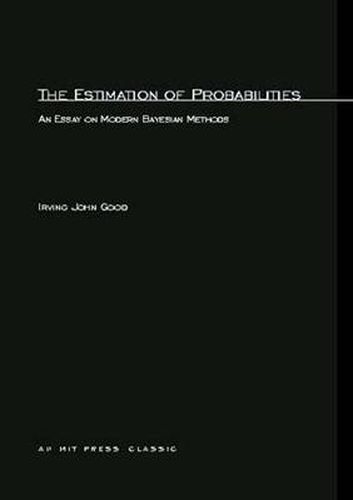Readings Newsletter
Become a Readings Member to make your shopping experience even easier.
Sign in or sign up for free!
You’re not far away from qualifying for FREE standard shipping within Australia
You’ve qualified for FREE standard shipping within Australia
The cart is loading…






The problem of how to estimate probabilities has interested philosophers, statisticians, actuaries, and mathematicians for a long time. It is currently of interest for automatic recognition, medical diagnosis, and artificial intelligence in general. This monograph reviews existing methods, including those that are new or have not been written up in a connected manner.
The problem of how to estimate probabilities has interested philosophers, statisticians, actuaries, and mathematicians for a long time. It is currently of interest for automatic recognition, medical diagnosis, and artificial intelligence in general. The main purpose of this monograph is to review existing methods, especially those that are new or have not been written about in an organized way. The need for nontrivial theory arises because our samples are usually too small for us to rely exclusively on the frequency definition of probability. Most of the techniques described in this book depend on a modern Bayesian approach. The maximum-entropy principle, also relevant to this discussion, is used in the last chapter. It is hoped that the book will stimulate further work in a field whose importance will increasingly be recognized.
Methods for estimating probabilities are related to another part of statistics, namely, significance testing, and example of this relationship are also presented.
Many readers will be persuaded by this work that it is necessary to make use of a theory of subjective probability in order to estimate physical probabilities and also that a useful idea is that of a hierarchy of three types of probability which can sometimes be identified with physical, logical, and subjective probabilities.
$9.00 standard shipping within Australia
FREE standard shipping within Australia for orders over $100.00
Express & International shipping calculated at checkout
Stock availability can be subject to change without notice. We recommend calling the shop or contacting our online team to check availability of low stock items. Please see our Shopping Online page for more details.
The problem of how to estimate probabilities has interested philosophers, statisticians, actuaries, and mathematicians for a long time. It is currently of interest for automatic recognition, medical diagnosis, and artificial intelligence in general. This monograph reviews existing methods, including those that are new or have not been written up in a connected manner.
The problem of how to estimate probabilities has interested philosophers, statisticians, actuaries, and mathematicians for a long time. It is currently of interest for automatic recognition, medical diagnosis, and artificial intelligence in general. The main purpose of this monograph is to review existing methods, especially those that are new or have not been written about in an organized way. The need for nontrivial theory arises because our samples are usually too small for us to rely exclusively on the frequency definition of probability. Most of the techniques described in this book depend on a modern Bayesian approach. The maximum-entropy principle, also relevant to this discussion, is used in the last chapter. It is hoped that the book will stimulate further work in a field whose importance will increasingly be recognized.
Methods for estimating probabilities are related to another part of statistics, namely, significance testing, and example of this relationship are also presented.
Many readers will be persuaded by this work that it is necessary to make use of a theory of subjective probability in order to estimate physical probabilities and also that a useful idea is that of a hierarchy of three types of probability which can sometimes be identified with physical, logical, and subjective probabilities.